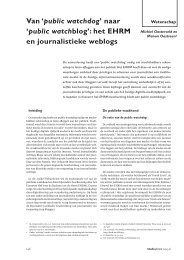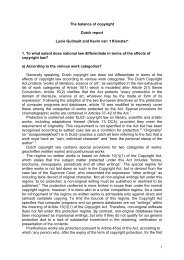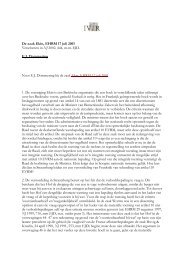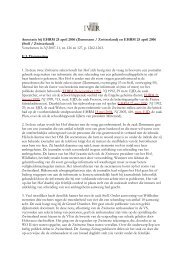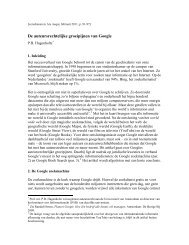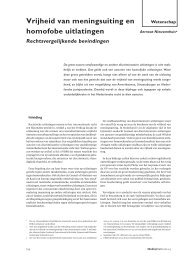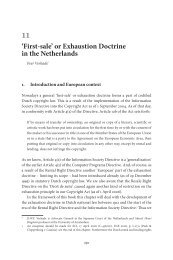unravelling the myth around open source licences - IViR
unravelling the myth around open source licences - IViR
unravelling the myth around open source licences - IViR
Create successful ePaper yourself
Turn your PDF publications into a flip-book with our unique Google optimized e-Paper software.
Chapter 5 concentrates on issues of copyright law. The <strong>open</strong> <strong>source</strong> software ideology, far<br />
from rejecting <strong>the</strong> rules of copyright law, relies on <strong>the</strong> application of <strong>the</strong>se rules to set <strong>the</strong>ir own<br />
‘<strong>open</strong>’ terms of use of protected software. The key terms in <strong>open</strong> <strong>licences</strong> have been designed to<br />
take account of <strong>the</strong> fact that <strong>the</strong> traditional distinction between creators and users of works has<br />
essentially vanished thanks to <strong>the</strong> digital networked environment: users are creators and vice-versa.<br />
To accommodate <strong>the</strong> incremental development of creative works, <strong>the</strong> <strong>licences</strong> grant users <strong>the</strong><br />
freedom to use, reproduce, modify <strong>the</strong> software, and <strong>the</strong> freedom to distribute or re-distribute <strong>the</strong><br />
work. How do <strong>the</strong>se freedoms fit in with rules on copyright? Considering <strong>the</strong> manner in which<br />
<strong>open</strong> <strong>source</strong> software is developed and used, three main aspects deserve our attention: first, <strong>the</strong><br />
question of joint authorship with respect to software created by more than one author; second, <strong>the</strong><br />
permitted uses under <strong>the</strong> most common <strong>open</strong> <strong>source</strong> <strong>licences</strong>; and third, <strong>the</strong> <strong>licences</strong>’ different<br />
obligations regarding <strong>the</strong> respect of moral rights. Chapter 6 examines <strong>the</strong> implications of <strong>the</strong><br />
recognition of <strong>the</strong> patentability of software-implemented inventions for <strong>the</strong> development of <strong>open</strong><br />
<strong>source</strong> software. To this end, we briefly consider <strong>the</strong> patent protection as it is currently granted in<br />
<strong>the</strong> Ne<strong>the</strong>rlands with respect to computer-implemented inventions, as well as <strong>the</strong> most relevant<br />
provisions of <strong>the</strong> proposed European directive on <strong>the</strong> patentability of computer-implemented<br />
inventions. In a subsequent subsection, we take a look at <strong>the</strong> reaction of some <strong>open</strong> <strong>source</strong> software<br />
developers in order to counter potential patent infringement claims from third parties. This includes<br />
<strong>the</strong> development of a patent strategy and <strong>the</strong> drafting of specific language such as <strong>the</strong> one appearing<br />
inside <strong>the</strong> GPL, and <strong>the</strong> Mozilla Public Licence.<br />
After having examined <strong>the</strong> rights and obligations of <strong>the</strong> respective parties under <strong>the</strong> most<br />
commonly used <strong>open</strong> <strong>source</strong> <strong>licences</strong>, chapter 7 takes a brief look at <strong>the</strong> issue of <strong>the</strong> enforcement of<br />
<strong>the</strong>se <strong>licences</strong>. Who has standing to sue, in <strong>the</strong> case of a work created by multiple decentralised<br />
authors? Considering that <strong>the</strong> <strong>open</strong> <strong>source</strong> ideology is based to a large extent on peer review, how<br />
are <strong>open</strong> <strong>source</strong> <strong>licences</strong> typically enforced in practice? Finally, chapter 8 will summarize <strong>the</strong> main<br />
conclusions of this study, and offer in chapter 9 a set of recommendations for possible adjustments<br />
to certain licence terms.<br />
In view of <strong>the</strong> proliferation of <strong>licences</strong> that are nowadays considered to fall under <strong>the</strong><br />
definition of ‘<strong>open</strong> <strong>source</strong>’, it is not our intention to examine every single one of <strong>the</strong>m. Instead, we<br />
shall concentrate in chapters 4, 5, and 6 on <strong>the</strong> provisions of <strong>the</strong> GNU GPL, <strong>the</strong> BSD, and <strong>the</strong><br />
Mozilla Public Licence. Moreover, it is not <strong>the</strong> ambition of this study to make an exhaustive review<br />
of all possible fields of <strong>the</strong> law that may have an impact on <strong>the</strong> use of <strong>open</strong> <strong>source</strong> <strong>licences</strong>. For<br />
example, issues of competition law, public procurement law, tax law, and private international law are<br />
left for a subsequent study. In addition, due to <strong>the</strong> nature of <strong>the</strong> publication process, several factual<br />
point in chapters 2 and 3 may have changed since <strong>the</strong> time of writing. Chapters 2 and 3 were written<br />
by Ot van Daalen initially in <strong>the</strong> Dutch language and later on translated into English by Ms. Leslie<br />
Hugenholtz. The authors would like to thank Eric Idema, student assistant, for his contribution in<br />
<strong>the</strong> research and <strong>the</strong> writing of parts of chapter 4. Special thanks go to Professor Edgar Du Perron<br />
(Faculty of Law, University of Amsterdam), Dr. Axel Metzger (Institut für Rechtsfragen der Freien<br />
und Open Source Software, Hamburg), Bart Knubben (Programma OSOSS, Ne<strong>the</strong>rlands), Margreet<br />
Groenenboom (Nauta Dutilh/<strong>IViR</strong>) and Coen Pustjens for <strong>the</strong>ir comments and suggestions<br />
regarding earlier drafts of this study.<br />
3



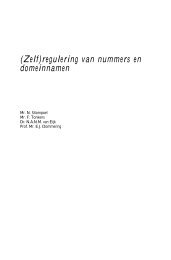
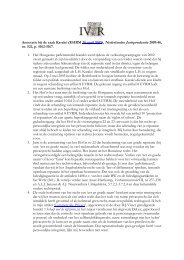

![Legal Opinion of Professor Egbert Dommering [1] concerning ... - IViR](https://img.yumpu.com/23603085/1/184x260/legal-opinion-of-professor-egbert-dommering-1-concerning-ivir.jpg?quality=85)
